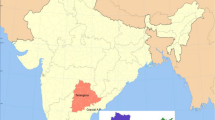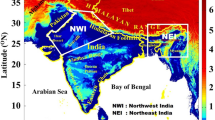Abstract
Thunderstorms and associated lightning flash activities are studied over two different locations in India with different terrain features. Lightning imaging sensor (LIS) data from 1998 to 2008 are analyzed during the pre-monsoon months (March, April and May). The eastern sector is designated as Sector A that represents a 2° × 2° square area enclosing Kolkata (22.65°N, 88.45°E) at the centre and covering Gangetic West Bengal, parts of Bihar and Orissa whereas the north-eastern sector designated as Sector B that also represents a 2° × 2° square area encircling Guwahati (26.10°N, 91.58°E) at the centre and covering Assam and foot hills of Himalaya of India. The stations Kolkata and Guwahati are selected for the present study from Sector A and Sector B, respectively, as these are the only stations over the selected areas having Radiosonde observatory. The result of the present study reveals that the characteristics of thunderstorms over the two locations are remarkably different. Lightning frequency is observed to be higher in Sector B than Sector A. The result further reveals that though the lightning frequency is less in Sector A, but the associated radiance is higher in Sector A than Sector B. It is also observed that the radiance increases linearly with convective available potential energy (CAPE) and their high correlation reveals that the lightning intensity can be estimated through the CAPE values. The sensitivity of lightning activity to CAPE is higher at the elevated station Guwahati (elevation 54 m) than Kolkata (elevation 6 m). Moderate resolution imaging spectrometer (MODIS) data products are used to obtain aerosol optical depth and cloud top temperature and employed to find their responses on lightning radiance.



















Similar content being viewed by others
Abbreviations
- AOD:
-
Aerosol optical depth
- CAPE:
-
Convective available potential energy
- Cb:
-
Cumulonimbus
- CTT:
-
Cloud top temperature
- FPM:
-
Flash per minute
- LIS:
-
Lightning imaging sensor
- MODIS:
-
Moderate resolution imaging spectrometer
- TRMM:
-
Tropical rainfall measuring mission
References
Baker MB, Christian HJ, Latham J (1995) A computational study of the relationships linking lightning frequency and other thundercloud parameters. Q J R Meteorol Soc 121:1525–1548
Blyth AM, Christian HJ, Driscoll K, Gadian AM, Latham J (2001) Determination of ice precipitation rates and thunderstorm anvil ice contents from satellite observations of lightning. Atmos Res 59–60:217–229
Boccippio DJ, Driscoll K, Hall J, Buechler DE (1998) LIS/OTD software guide. Global Hydrology and Climate Center
Chakrabarti D, Biswas HR, Das GK, Kore PA (2008) Observational aspects and analysis of events of severe thunderstorms during April and May 2006 for Assam and adjoining states—a case study on ‘Pilot Storm Project’. Mausam 59:461–478
Chaudhuri S (2008a) Preferred type of cloud in the genesis of severe thunderstorms—a soft computing approach. Atmos Res 88:149–156
Chaudhuri S (2008b) Identification of the level of downdraft formation during severe thunderstorms: a frequency domain analysis. Meteorol Atmos Phys 102(1–2):123
Chaudhuri S (2010a) Convective energies in forecasting severe thunderstorms with one hidden layer neural net and variable learning rate back propagation algorithm. Asia Pac J Atmos Sci 46(2):173–183
Chaudhuri S (2010b) Predictability of severe thunderstorms with fractal dimension approach. Asian J Water Air Environ Pollut 7(4):81–87
Chaudhuri S (2011a) Implementation of intuitionistic fuzzy logic to assess the predictability of severe thunderstorms. Asia Pac J Atmos Sci 47(5):477–483
Chaudhuri S (2011b) A probe for consistency in CAPE and CINE during the prevalence of severe thunderstorms: statistical—fuzzy coupled approach. Atmos Climat Sci 4(1):197–205
Chaudhuri S, Aich Bhowmick S (2006) CAPE—a link amid thermodynamics and microphysics for the occurrence of severe thunderstorms. Mausam 57(2):249–254
Chaudhuri S, Biswas M (2009) Pattern of meteorological parameters during severe thunderstorms—a frequency domain analysis. Mausam 60(1):1–10
Chaudhuri S, Middey A (2009) Applicability of bipartite graph model for thunderstorms forecast over Kolkata. Adv Meteorol 2009:1–12
Chaudhuri S, Middey A (2011a) Nowcasting thunderstorms with graph spectral distance and entropy estimation. Meteorol Appl 18(2):238–249
Chaudhuri S, Middey A (2011b) Adaptive neuro-fuzzy inference system to forecast peak gust speed during thunderstorms. Meteorol Atmos Phys 114:139–149
Gatlin PN, Goodman SJ (2010) A total lightning trending algorithm to identify severe thunderstorms. J Atmos Ocean Technol 27:3–22
Guha A, De BK (2009) Lightning electrical characteristics during tropical summer thunderstorm in north-east India. J Atmos Sol Terr Phys 71:1365–1373
IMD (1941) Nor’westers of Bengal. India Meteorological Department, Tech. Note No. 10
Jacobson AR, Boeck W, Jeffery C (2007) Comparison of narrow bipolar events with ordinary lightning as proxies for the microwave-radiometry ice-scattering signature. Mon Weather Rev 135:1354–1363
Kar SK, Liou YA, Ha KJ (2009) Aerosol effects on the enhancement of cloud-to-ground lightning over major urban areas of South Korea. Atmos Res 92:540
Khain A, Cohen N, Lynn B, Pokrovsky A (2008) Possible aerosol effects on lightning activity and structure of hurricanes. J Atmos Sci 65:3652–3667
King MD, Kaufman YJ, Menzel WP, Tanre D (1992) Remote-sensing of cloud, aerosol, and water-vapor properties from the moderate resolution imaging spectrometer (MODIS). IEEE Trans Geosci Remote Sens 30:2–27
Koshak WJ, Stewart MF, Christian HJ, James WB, Hall JM, Solakiewicz RJ (2000) Laboratory calibration of the optical transient detector and the lightning imaging sensor. J Atmos Ocean Technol 17(7):905–915
Koteswaram P, Srinivasan V (1958) Thunderstorms over Gangetic West Bengal in the pre-monsoon season and synoptic factors favorable of their formation. Indian J Meteorol Geophys 9:301–312
Kumar G, Mohapatra M (2006) Some climatological aspects of thunderstorms and squalls over Guwahati airport. Mausam 57(2):231–240
Lal DM, Pawar SD (2009) Relationship between rainfall and lightning over central Indian region in monsoon and premonsoon seasons. Atmos Res 92(4):402–410
Manohar GK, Kandalgaokar SS, Tinmaker MIR (1999) Thunderstorm activity over India and Indian south-west monsoon. J Geophys Res 104:41–69
McCaul EW Jr, Goodman SJ, LaCasse KM, Cecil DJ (2009) Forecasting lightning threat using cloud-resolving model simulations. Weather Forecast 24:709–729
Mukherjee AK, Arunachalam G, Rakshit DK (1964) Study of thunderstorm around Guwahati airport. Indian J Meteorol Geophys 15:425–430
Mukhopadhyay P, Singh HAK, Mahakur M (2009) The interaction of large scale and mesoscale environment leading to formation of intense thunderstorms over Kolkata. Part I: Doppler radar and satellite observations. J Earth Syst Science 118(5):441–466
Pessi AT, Businger S, Cummins KL, Demetriades NWS, Murphy M, Pifer B (2009) Development of a long-range lightning detection network for the Pacific: construction, calibration, and performance. J Atmos Ocean Technol 26:145–166
Price C (1993) Global surface temperatures and the Earth’s electric circuit. Geophys Res Lett 20:1363–1366
Ramesh Kumar P, Kamra AK (2010) Lightning activity variations over three islands in a tropical monsoon region. Atmos Res 98(2–4):309–316
Reeve N, Toumi R (1999) Lightning activity as an indicator of climate change. Q J R Meteorol Soc 126:893–904
Steiger SM, Orville RE, Carey LD (2007) Total lightning signatures of thunderstorm intensity over north Texas. Part II: mesoscale convective systems. Mon Weather Rev 135:3303–3324
Timothy JL, Rutledge SA (2002) Relationships between convective storm kinematics, precipitation, and lightning. Mon Weather Rev 130:2492–2506
Tinmaker MIR, Ali Kaushar, Beig G (2010) Relationship between lightning activity over peninsular India and sea surface temperature. J Appl Meteorol Climatol 49:828–835
Tyagi A (2007) Thunderstorm climatology over Indian region. Mausam 58(2):189–212
Williams ER (1985) Large scale charge separation in thunderclouds. J Geophys Res 90:6013–6025
Williams ER (1992) The Schumann resonance: a global tropical thermometer. Science 256:1184–1187
Acknowledgments
The first author acknowledges the India Meteorological Department (IMD), Govt. of India for providing the thunderstorm records and the respective websites for making the meteorological and satellite data available for scientific endeavour. The authors thank the anonymous reviewers for favourable comments and constructive suggestions which helped to improve the clarity of the paper.
Author information
Authors and Affiliations
Corresponding author
Additional information
Communicated by Responsible editor: M. Kaplan.
Rights and permissions
About this article
Cite this article
Chaudhuri, S., Middey, A. Disparity in the characteristic of thunderstorms and associated lightning activities over dissimilar terrains. Meteorol Atmos Phys 119, 151–161 (2013). https://doi.org/10.1007/s00703-012-0226-4
Received:
Accepted:
Published:
Issue Date:
DOI: https://doi.org/10.1007/s00703-012-0226-4




